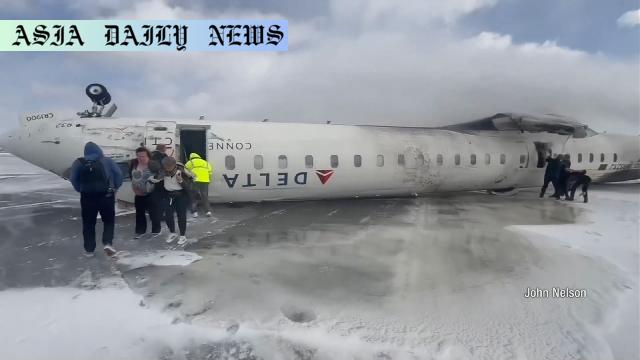Crash at Toronto’s Pearson Airport as a Delta Air Lines plane flips on snowy ground while landing; 18 people injured.
Crash: A Delta Air Lines plane flipped on landing in Toronto.
Eighteen injuries reported, including three severe casualties.
Operations at the airport were temporarily paused post-incident.

Delta Air Lines Plane in Dramatic Crash at Toronto Airport
On a snow-covered runway at Toronto’s Pearson Airport, a Delta Air Lines plane experienced a terrifying crash, leaving the aviation community in shock. Operated by a Delta Air Lines subsidiary, the passenger jet was inbound from Minneapolis when it failed to land successfully, flipping onto its back. The aircraft’s primary wing was severely damaged, and video footage captured shows the overturned plane amidst tumultuous weather.
All 80 Passengers Safely Evacuated but Injuries Reported
Miraculously, all 80 passengers onboard successfully evacuated from the aircraft. However, 18 passengers suffered injuries, three of which are reported to be severe. Emergency responders quickly took action, transporting the injured to nearby hospitals for treatment. The swift and efficient rescue operation ensured the immediate safety of survivors on the scene. These extraordinary efforts underscore the critical role of well-coordinated airport emergency protocols.
Temporary Airport Closure and Continuous Challenges
The crash prompted the temporary closure of Toronto Pearson Airport, affecting numerous flights and passengers for hours. Snowy conditions on the ground raised questions about the role inclement weather may have played in the incident. Experts have pointed out the importance of robust aviation safety standards, particularly under adverse weather conditions, as investigations continue to uncover the precise cause of the crash.
Video Footage Depicts the Chaotic Scene
Footage of the incident depicts the upside-down plane surrounded by emergency responders and covered in snow, with fire engines dousing it in water. Passengers were seen hastily escaping the aircraft, some visibly distressed. The scene highlights the precarious nature of aviation accidents and underscores the need for ongoing improvements in safety measures and pilot training.
Potential Ramifications for Delta Air Lines
Delta Air Lines now faces significant scrutiny, not only around the operational practices of its subsidiary but also regarding its broader safety policies. This incident will likely lead to a detailed investigation by aviation authorities to determine if mechanical issues, human error, weather conditions, or a combination of factors contributed to the crash. Pending the results of the investigation, Delta will need to reinforce its commitment to passenger safety.
Aviation Experts Investigate the Incident
The incident is already shaping the narrative around air travel safety amidst harsh weather environments. Aviation experts are closely examining the operational elements leading to the crash, with emphasis on the snow-covered runway and other environmental factors. The role of the airline’s maintenance and piloting precision will also likely play a major part in the final report.
While air travel remains statistically safe, incidents like these serve as stark reminders of the risks involved. As investigations unfold, passengers worldwide look towards aviation authorities and companies like Delta Air Lines to address and mitigate such incidents in the future.
Commentary
Reflecting on the Delta Airlines Incident
The recent crash at Toronto Pearson Airport involving a Delta Air Lines aircraft has once again brought aviation safety into the spotlight. The fact that all 80 passengers were able to evacuate the flipped plane safely is undoubtedly a testament to the quick-thinking crew and emergency responders. However, with 18 reported injuries, some severe, this incident also calls for deeper evaluations into what caused this frightening mishap.
The Role of Weather and Safety Measures
Weather-related challenges in aviation are not new, but incidents like these raise the stakes. Snowy and icy conditions may likely have played a role, yet airlines must be prepared to handle such circumstances effectively. Pilot training programs, airplane maintenance, and runway preparations are all factors that must align precisely to prevent such accidents. As winter months approach globally, this mishap is a stark reminder of the importance of vigilance in adverse weather safety protocols.
Looking Forward
Delta Air Lines has been a trusted name in global aviation, making this incident particularly surprising and unfortunate. While no airline is free from risk, incidents like these underline the structural and operational improvements needed to ensure passenger safety. The onus should also be on aviation regulators and safety organizations to ensure transparency during the investigation and accountability if lapses are identified.
Ultimately, passengers must feel safe when they board a flight, knowing that every precaution has been taken, and every risk understood. Stories of resilience, like the successful evacuation of all passengers, provide hope amidst the challenges but should act as stepping stones towards even greater advancements in aviation safety.


